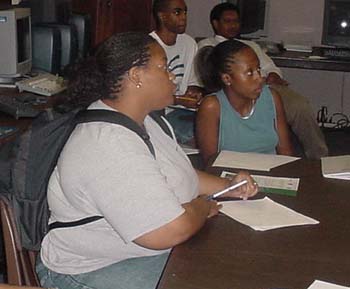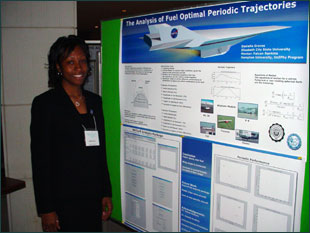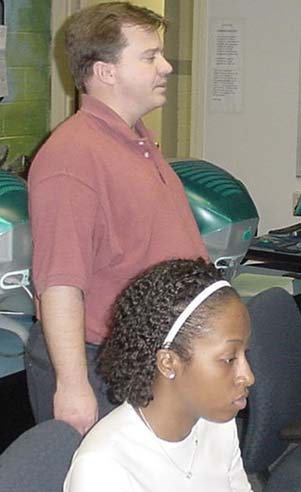
2003 Undergraduate Research
Experiences in
Ocean, Marine, and Space Science
May
27, 2003-July 18, 2003
Maritime
Remote Sensing Research:
Locating the Remnants of the "Lost Colony of Roanoke"

ABSTRACT
In a world of science, technology,
and national security, remote sensing technology has emerged as a primary
tool for retrieving and interpreting geographical data. Our research
project, "Science, Settlement , and Remote Sensing," aims
to expand the application of remote sensing technology by answering
the question: What happened to the "Lost Colony of Roanoke?"
Our research takes and interdisciplinary approach from this 400-year
old question by drawing on a wide-range of primary and secondary sources
from history, geography, archaeology, and most importantly, remote sensing
technology. Challenging some of the key scholarly assumptions about
the fate of the "Lost Colony," we argue that the remnants
of the "Lost Colony" can be located in Northeast North Carolina.
In particular, our research strongly suggests that the final fate of
the "Lost Colony" can be traced back to Buck Ridge near Roanoke
Island.
Office of Naval Research
Nurturing ECSU Research Talent (NERT) Program
September 2002-April 2003
"How to Site Manage Networks, Computers,
and Services Using Administrative Tools"

ABSTRACT
The Elizabeth
City State University Office of Naval Research 2002 – 2003 Networking
Team will implement local and global site polices that will allow the
Network Team to effectively administer the existing ONR and Cerser networks.
First, the implementation of local security policies using Microsoft
and Solaris Management Console will be used to prevent unauthorized
user access and disk quota restrictions. Second, the migration of the
existing NIA Web server from an Indy platform to a Silicon Graphics
O2 platform will allow end-users to access its shared resources with
a shorter wait state. Third, using packet analysis administrator tools
to conduct a post-implementation review of the existing wireless LAN
data throughput will be analyzed for data degradation within the Macintosh
LAB. Fourth, load balancing the TeraScan file server, Seaserver, which
is located in the Cerser Lab of Dixon Hall and the development of shell
scripts to control the removal of monitoring, and trouble shooting in
a Unix, Macintosh, and Windows 2000 Network Infrastructure will allow
the 2003 Network team to effectively site manage the Mathematics and
Computer Science Office of Naval Research Lab.
Site Management requires the Networking team to collect data from two
different physical locations in one domain. Both Lester and Dixon Hall
consist of 20 to 30 nodes in the Cerser and Office of Naval Research
Lab. Each node may be a dual or single boot workstation or server running
UNIX, Mandrake 9.0 and Windows 2000, and/or Macintosh x as the operating
system. To keep track of open and/or closed projects, each team member
maintains a Trouble Ticket Log file on the ecsu.edu LAN. Monitoring
both sites is conducted by observing each node system’s use and
performance. To collect system data, the Network Team used one utility,
called task Manager, which runs on a windows 2000 platform to display
general system performance that can be recorded into a log file for
future analysis.
Undergraduate Institute in Physics-
Research Experience for Undergradutes
(UnIPhy-REU)
June 3, 2002-August 24, 2002
"The Analysis of Fuel Optimal Periodic Trajectories"

ABSTRACT
In this research, conventional aircraft were flown on periodic
cruise trajectories using an optimization program to determine if flying
periodically is more fuel efficient than flying steady state. This research
also included the development of an analysis package using MATLAB. The
analysis package was used to carefully examine the results from the
optimization program.
Office of Naval Research
Nurturing ECSU Research Talent (NERT) Program
August 2001-May 2003
"Math of The
Great Dismal Swamp:"
CD-Rom Production Project

ABSTRACT
The Great
Dismal Swamp, located in northeastern North Carolina and southeastern
Virginia, is one of the most unique, natural wetlands of the world.
The Great Dismal Swamp Boardwalk Hydrology Project at Elizabeth City
State University began in the fall of 1996. Its purpose was to determine
the quality of the water in the Great Dismal Swamp and to understand
how and why the water quality changes. The data collected helped to
explain the changes that take place with the swamp's water throughout
the year in regard to water table pulsing, pH, nitrate nitrogen, phosphate,
conductivity, and dissolved oxygen.
Utilizing
various software presentation packages, the multimedia team will develop
software that will present the water quality research, history, and
geography of the swamp in electronic format. This knowledge will then
be used to draw students into interactive lessons in mathematics such
as measuring and graphing based on the Principles and Standards for
School Mathematics from the National Council of Teachers of Mathematics.
The target audience for this software will be the classroom of the K-3rd
grades and the delivery method will be via CD with web-based delivery
to follow in the fall of 2002.